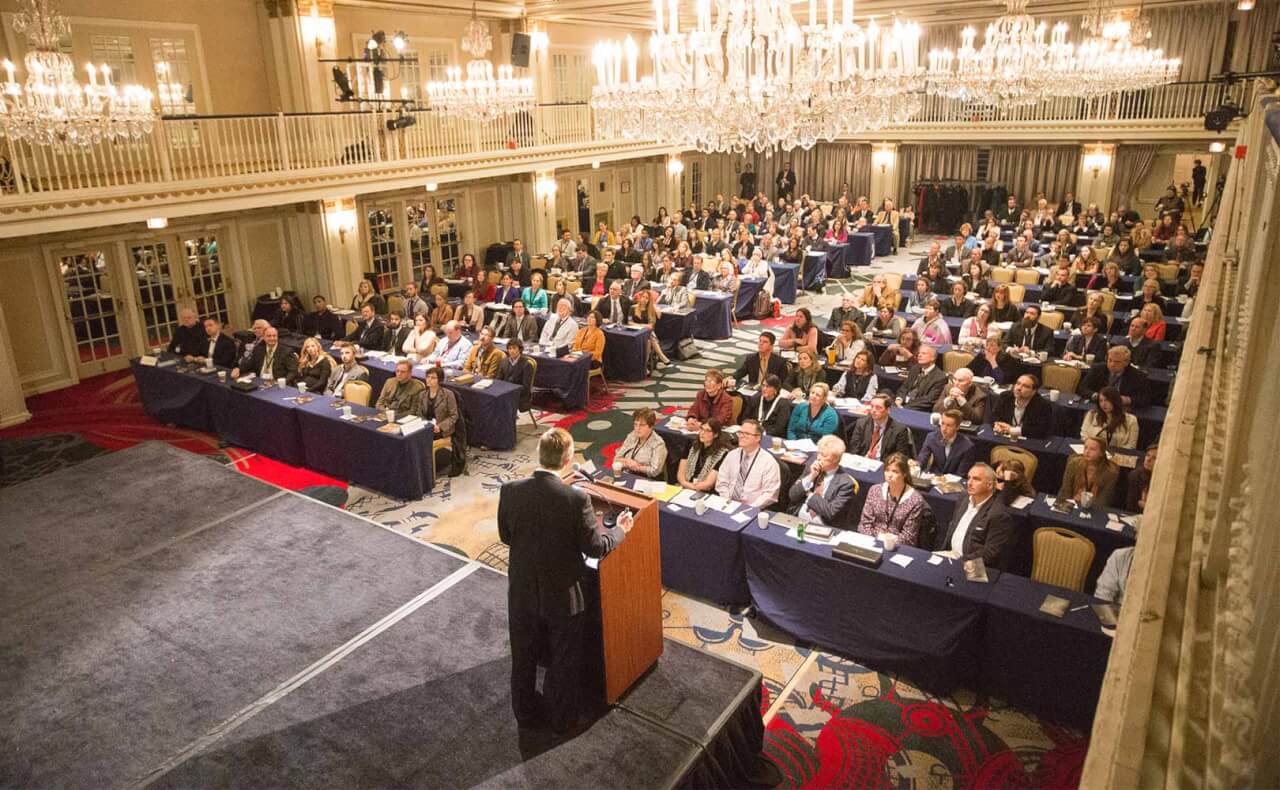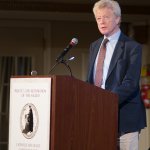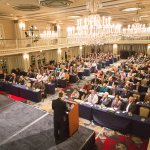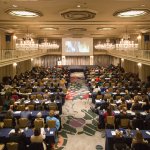All photos courtesy of Ruth Durkin.
On the Feast of the Christ the King, the center of the faithful Catholic world was briefly focused on the Drake Hotel in Chicago, IL, as over 200 members of the Catholic Art Guild, their supporters, and patrons met for their first annual “Conference on Beauty and the restoration of the Sacred.” (Full disclosure: I was given a complimentary ticket to the conference so that I could share my impressions with you.) An organization of St. John Cantius Parish – itself a vital center of the “restoration of the sacred” – the Catholic Art Guild is dedicated to the restoration of authentic beauty in Catholic liturgy and life. In a time during which many faithful Catholics are overwhelmed by darkness and tempted to despair, a bright light was shone revealing the long simmering contemporary Catholic aesthetic renaissance, here unified and made vitally present. Lovers of the Church and the Beauty of Christ all, conference attendees from around the country were able to seek mutual support, discuss the reality of the situation before the Church, and chart bold new paths forward in their aesthetic vocations and patronage aims.
The conference began in the newly restored St. John Cantius Church with a 12:30 High Mass including immaculately sung traditional chant and the luminous Missa Ecce quam Bonum by Hans Leo Hassler. Rogier’s Dominus regit me and Jacob Handl’s In Nomine Jesu were also sung, while the powerful liturgy concluded with the Acclamations (Christus Vincit), all in keeping with the quality which recently earned SJC their Sony Classical recording deal. After Mass, attendees were ferried from the church to the Drake hotel and conference center by coach bus, immediately allowing for valuable networking and conversations to begin. One of the hidden themes of the conference was “it’s nice to finally meet you!”, as many distant contacts and Facebook friends met in person for the very first time.
Brief refreshments and social time was quickly followed by the schedule of four speakers, beginning with one of the long-standing deans of American Catholic art, Anthony Visco. Cheerfully greeting a “roomful of survivors of modernism”, Mr. Visco brought his signature charm and wit to bear on the problems of the current poverty of cultural beauty and the sufficiency of the Catholic tradition to surely address this crisis. A valuable part of his talk involved the necessity to create Catholic programs of “how to re-see”, including energetic new initiatives in art education. Also intriguing (and applicable even beyond the visual arts) were his “Four Modalities” of art, something that could easily bear a separate workshop setting.
Dr. Denis McNamara spoke next, giving perhaps the most philosophically practical talk of the evening in his attempt to define the standards which can be used to judge good Church art and architecture. “We call a thing beautiful when it reveals something of its ontology”, he said, proceeding then to present an Incarnational vision of sacred art and architecture being most effective (and most Catholic) when addressing this ontological reality. Discussing great examples of Catholic art which revealed the truth of Catholic eschatology, he said that a great function of sacred art is to help us “to be encouraged for our own transfiguration.” “Artists,” said McNamara, “reach into the mind of God and bring that image back down to earth.” This was presented rather as an awesome responsibility which should generate something more akin to humility and less like romantic personalism, with not personal opinion but ontological reality being the standard of quality in sacred art. “Beauty is”, said McNamara, “a flash of understanding which approaches the way God understands.”
Famed Catholic architect Duncan Stroik also gave a deeply informative presentation which worked from a surmising of our current dismal cultural and ecclesial aesthetic situation towards a clear presentation of how we can do better. Continuing the theme of contrasting the cult of the ugly with the authentic culture of beauty, Professor Stroik strongly encouraged the further development of vital and spiritually mature patronage for the sacred arts. Speaking to the need for artists to have the guiding light of a good, spiritually formed, and holy patron, he urged future patrons to enable and “allow the artist to create a relative of the great art, not a clone.” His talk was strongly buoyed by modern examples of projects which including the vital mix of exceptional artistry, dedicated patronage, funding, and the budget for both good materials and the time to apply them well.
The night’s featured speaker, philosopher Sir Roger Scruton, would cap off the exciting evening by focusing on the nature of beauty and the need for an everyday aesthetic. An author of over 40 books in the area of aesthetics and philosophy, Scruton’s public profile has increased lately due to both his knighting and his wonderful BBC documentary “Why Beauty Matters.” Scruton began with a surprising turn, discussing Kant’s writings on the limits of human knowledge, and pairing this with the sociological view of the universal sense of the sacred. Dismissing the view from scientism (which attempts to explain aesthetic experience in a purely Darwinian mode), he demonstrated how sacred art indeed brushes up against this Kantian boundary of human knowledge, its very sacredness proved by both its singular striving and also by its ability to be desecrated. Following up on a powerful theme in his Oxford book “Beauty: A Very Short Introduction”, he spoke of modern society’s desire to desecrate religion, the arts, and even the human face – in everything from modernistic art to pornography to “Tarantino-esque violence”, discarding and eradicating the moral judgment inherent in such objects. In contrast to such daily drudgery and the cult of desecration, Scruton spoke to his Catholic audience by stating that “One of the great triumphs of the Roman Catholic Church was to make the Mass something ordinary yet extraordinary.” Speaking to the real importance of objective aesthetic values, he encouraged patrons to begin by rebuilding a culture of authentic beauty through the pursuit of a clear “aesthetic of the every day”. It was also touching to see how Sir Roger – who is an Anglican – was a bit taken aback by the enthusiasm his works had exercised on an almost entirely Catholic audience.
Dinner was held in the gorgeous Drake hotel Ballroom, a stunning space which itself was a rare survivor of the urge to “modernize” during the previous century. A panel discussion followed the meal, in which the speakers were asked questions from conference attendees.
While the theme of the conference may have been “Beauty and the Restoration of the Sacred”, a number of sub-themes emerged during these discussions. There was something truly cathartic for artists to be able to openly and safely express their dismay at both the general confusion in the world and the deep-seeded aesthetic confusion in the Church, while also sharing their real career struggles and concerns. Over and over again, artists would speak some version of: “I know that God wants me to create Beautiful art, and I am desperate to find as many ways to do it in service of the Church and her people as possible.” The hidden renaissance was therefore brought into the open, revealing a great resource of love and talent brimming with the enthusiasm and desire to serve Holy Mother Church. As one of the conference speakers said, “looking out at this room, there is never an excuse to make another ugly artwork or build another ugly church again!”
The efforts of the Catholic Art Guild and St. John Cantius Parish, as well as the great spiritual patronage and practical assistance of the Priests there – especially pastor Rev. Frank Phillips and Rev. Joshua Caswell – all deserve great praise for undertaking the organizing of this vitally important conference. Their reward was an enthusiastic packed house at the Drake, and the most beautiful and believable words uttered that evening: “annual.” Great credit also goes to Kathleen Carr, Catholic Art Guild President and co-founder, who essentially gave up a year of her time and work in order to make this organization and its vital first conference a reality.







